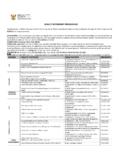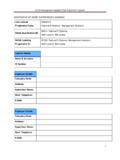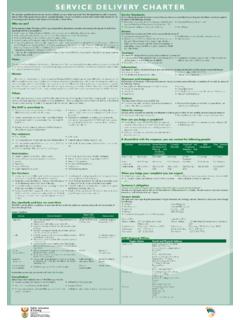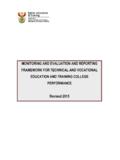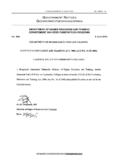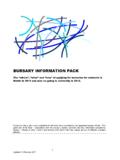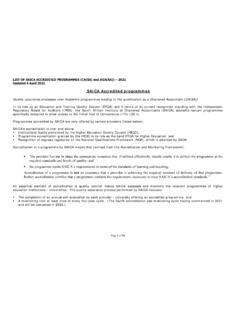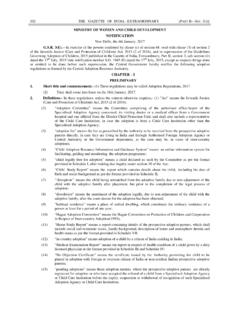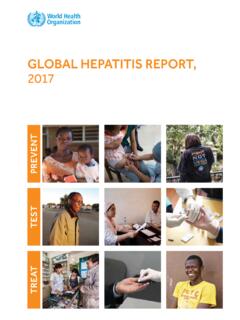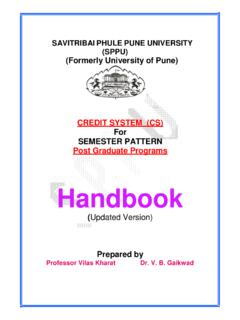Transcription of Report on Skills Supply and Demand in South Africa
1 Skills Supply AND Demand IN South AFRICASKILLS Supply AND Demand IN South Africa MARCH 2019 i Department of Higher Education and Training 123 Francis Baard Street PRETORIA 0001 Tel: 08000 87 22 22 Published by the Department of Higher Education and Training. Department of Higher Education and Training, 2019 This publication may be used in part or as a whole, provided that the Department is acknowledged as the source of information, and is cited as follows: Department of Higher Education and Training. 2019. Skills Supply and Demand in South Africa . Pretoria. Department of Higher Education and Training. ISBN: 978-1-77018-850-1 This Report is available on the Department of Higher Education and Training s website: Enquiries: The Director: System Monitoring and Economic Analysis Tel: +27 (012) 312 5465/5595 Email: ii ACKNOWLEDGEMENTS The Department of Higher Education and Training (DHET) wishes to thank Statistics South Africa (StatsSA) for provision of data used in this Report on Skills Supply and Demand in South Africa .
2 Special thanks are extended to colleagues in several branches of the Department for contributions they made in various forms towards preparation of this Report . iii TABLE OF CONTENTS ACKNOWLEDGEMENTS .. ii TABLE OF CONTENTS .. iii LIST OF FIGURES .. vi LIST OF TABLES .. viii ACRONYMS AND ABBREVIATIONS .. ix FOREWORD BY THE DIRECTOR-GENERAL .. x EXECUTIVE SUMMARY .. xi CHAPTER 1: INTRODUCTION TO THE Report ON Skills Supply AND Demand IN South Africa .. 1 South Africa S CURRENT SOCIOECONOMIC CONTEXT .. 2 POLICY IMPERATIVES FOR Skills PLANNING .. 5 The Reconstruction and development programme .. 5 The Growth, Employment and Redistribution strategy .. 5 Accelerated Shared Growth Initiative of South Africa (AsgiSA) and Joint Initiative on Priority Skills Acquisition.
3 7 The Human Resources development Strategy for South Africa .. 7 The National Skills development Strategy .. 8 The New Growth Path .. 8 National development Plan .. 8 The White Paper on Post-School Education and Training ( the White Paper ) .. 9 RATIONALE FOR Skills PLANNING .. 9 AIMS AND OBJECTIVES OF THE Report ON Skills Demand AND Supply IN South Africa ..12 METHODOLOGY AND METHODOLOGICAL ISSUES ..13 DEFINING SKILL ..13 UNDERSTANDING Skills Demand ..13 UNDERSTANDING Skills Supply ..14 UNDERSTANDING Skills MISMATCHES ..14 LIMITATIONS FOR THE APPROACH ..15 STRUCTURE OF THE Report ON Skills Demand AND Supply IN South Africa ..16 CHAPTER 2: ECONOMIC GROWTH AND EMPLOYMENT IN THE South AFRICAN ECONOMY: A BRIEF OVERVIEW ..17 ECONOMIC FIXED INVESTMENT AND SAVINGS.
4 20 EXPORT GROWTH AND DIVERSIFICATION ..22 MIDDLE INCOME COUNTRY COMPARISON ..25 EMPLOYMENT TRENDS ..27 CONCLUDING COMMENTS AND IMPLICATIONS FOR Skills CHAPTER 3: THE South AFRICAN LABOUR iv South AFRICAN LABOUR FORCE: OVERVIEW ..33 WHO ARE THE EMPLOYED AND THE UNEMPLOYED? ..34 SPATIAL LOCATION OF THE EMPLOYED AND UNEMPLOYED ..34 GENDER AND POPULATION GROUP OF THE EMPLOYED AND AGE DISTRIBUTION OF THE EMPLOYED AND UNEMPLOYED POPULATION ..37 EDUCATION LEVEL OF THE EMPLOYED AND UNEMPLOYED POPULATION ..38 YOUTH EMPLOYMENT vs. UNEMPLOYMENT ..41 AGE PROFILE OF THE YOUTH ..41 THE EDUCATION LEVEL OF YOUTH ..43 IMMIGRANTS IN THE LABOUR FORCE ..46 CONCLUDING REMARKS AND IMPLICATIONS FOR Skills CHAPTER 4: Skills Supply IN South Africa .
5 50 THE SCHOOLING SYSTEM ..50 PROFILE OF THE UNIVERSITY, TVET AND CET SECTORS ..52 CET COLLEGES: ACCESS, EQUITY AND SUCCESS ..55 TVET COLLEGES: COURSES, QUALIFICATIONS AND Skills ..57 PUBLIC HIGHER EDUCATION INSTITUTIONS: ENROLMENTS, QUALIFICATIONS AND Skills ..60 ENROLMENTS AND PUBLIC HIGHER EDUCATION INSTITUTIONS COMPLETION BY GENDER AND SETA-SUPPORTED LEARNING PROGRAMMES ..65 CONCLUDING COMMENTS AND IMPLICATIONS FOR Skills CHAPTER 5: UNDERSTANDING Demand THROUGH CHANGES IN THE STRUCTURE OF EMPLOYMENT ..70 EMPLOYMENT DISTRIBUTION BY INDUSTRIAL SECTOR ..70 AGRICULTURE, HUNTING, FORESTRY AND FISHING ..73 MINING AND QUARRYING ..73 MANUFACTURING ..73 ELECTRICITY, GAS AND WATER Supply ..74 CONSTRUCTION ..74 WHOLESALE AND RETAIL TRADE.
6 75 TRANSPORT, STORAGE AND COMMUNICATION ..75 FINANCIAL INTERMEDIATION, INSURANCE, REAL ESTATE AND BUSINESS ..76 COMMUNITY, SOCIAL AND PERSONAL SERVICES ..76 TRENDS IN THE OCCUPATIONAL STRUCTURE IN THE LABOUR MARKET ..77 THE EMPLOYED BY SECTOR AND OCCUPATION ..78 CHANGES IN THE EDUCATIONAL LEVELS OF OCCUPATIONAL GROUPS ..79 STRATEGIC INTEGRATED PROJECTS ..80 OCCUPATIONS IN HIGH Demand ..80 CONCLUDING COMMENTS AND Skills IMPLICATIONS ..84 CHAPTER 6: UNDERSTANDING Skills MISMATCHES ..85 v RATIONALE FOR UNDERSTANDING Skills IMBALANCES ..85 FORMS OF Skills IMBALANCES ..85 INDICATORS OF Skills IMBALANCES ..86 SKILL NEEDS INDICATORS ..87 OCCUPATIONAL-LEVEL SHORTAGES AND SURPLUSES ..88 INDUSTRY-LEVEL OCCUPATIONAL SHORTAGES AND SURPLUSES.
7 90 SKILL-LEVEL SHORTAGES AND MISMATCH INDICATORS ..95 CONCLUDING COMMENTS AND IMPLICATIONS FOR Skills CHAPTER 7: Skills Supply AND Demand : KEY vi LIST OF FIGURES Figure 1: Framework for the analysis of Skills Supply , Demand and Figure 2: Trends in absolute value of GDP and real GDP growth, 1994 to 2016 ..18 Figure 3: Trends in sectoral average GDP growth rates, 1994 to 2017 ..19 Figure 4: Sectoral contribution to GDP, 1994 and 2017 ..20 Figure 5: Ratio of savings and investment relative to South Africa , 1994 to 2016 ..21 Figure 6: Export and import capacity (as % of GDP), 1994 to 2016 ..23 Figure 7: Comparison of average annual growth rates of GDP per capita, 1994 to 2016 ..25 Figure 8: Comparison of average annual growth in value added by sector, 1994 to 2016.
8 26 Figure 9: Middle-income country comparison of unemployment rates, 1994, 2014, 2016 and 2017 ..26 Figure 10: Trends in unemployment rate, 2000 to 2017 ..31 Figure 11: Jobs deficit: Gap between working-age population and employed population (million), 2010 to 2017 ..33 Figure 12: Provincial GDP, employment and unemployment, 2016 ..34 Figure 13: Employed population by gender, 2010 to 2017 ..35 Figure 14: Employed population by population group, 2010 to 2017 ..35 Figure 15: Unemployed population by gender, 2010 to 2017 ..36 Figure 16: Unemployed population by population group, 2010 to 2017 ..36 Figure 17: Age distribution of the employed population, 2010, 2014, 2016 and 2017 ..37 Figure 18: Age distribution of the unemployed population, 2010, 2014, 2016 and 2017.
9 37 Figure 19: Highest education level of the employed population, 2010, 2014, 2016 and 2017 ..38 Figure 20: Highest education level of the unemployed population, 2010, 2014, 2016 and 2017 ..39 Figure 21: Trends in tertiary and degree graduate qualifications among the employed, 2010, 2014, 2016 and 2017 ..39 Figure 22: Percentage of 25-64 year-olds with tertiary education by level of tertiary education, 2015 ..40 Figure 23: Share of age groups of employed youth, 2010, 2014, 2016 and 2017 ..42 Figure 24: Share of groups of unemployed youth, 2010, 2014, 2016 and 2017 ..42 Figure 25: Distribution of youth by highest level of education for 2010, 2014, 2016 and Figure 26: Share of education levels of employed youth, 2010, 2014, 2016 and 2017.
10 43 Figure 27: Share of education levels of unemployed youth, 2010, 2014, 2016 and 2017 ..44 Figure 28: Share of education levels of employed youth by age group, 2017 ..45 Figure 29: Share of education levels of unemployed youth by age group, 2017 ..45 Figure 30: Number and percentage of learners achieving matriculation with bachelor s pass and Mathematics passes at higher than 50% from 2010 to 2017 ..51 Figure 31: Changing enrolment patterns in public Universities and TVET sector, 2010 to 2016 ..53 Figure 32: Gross enrolment ratio in Community Education and Training colleges (students enrolled as percentage of 15-35-year-olds), 2010-2016 ..55 Figure 33: Enrolment in Community Education and Training colleges by gender, 2010-2016.
